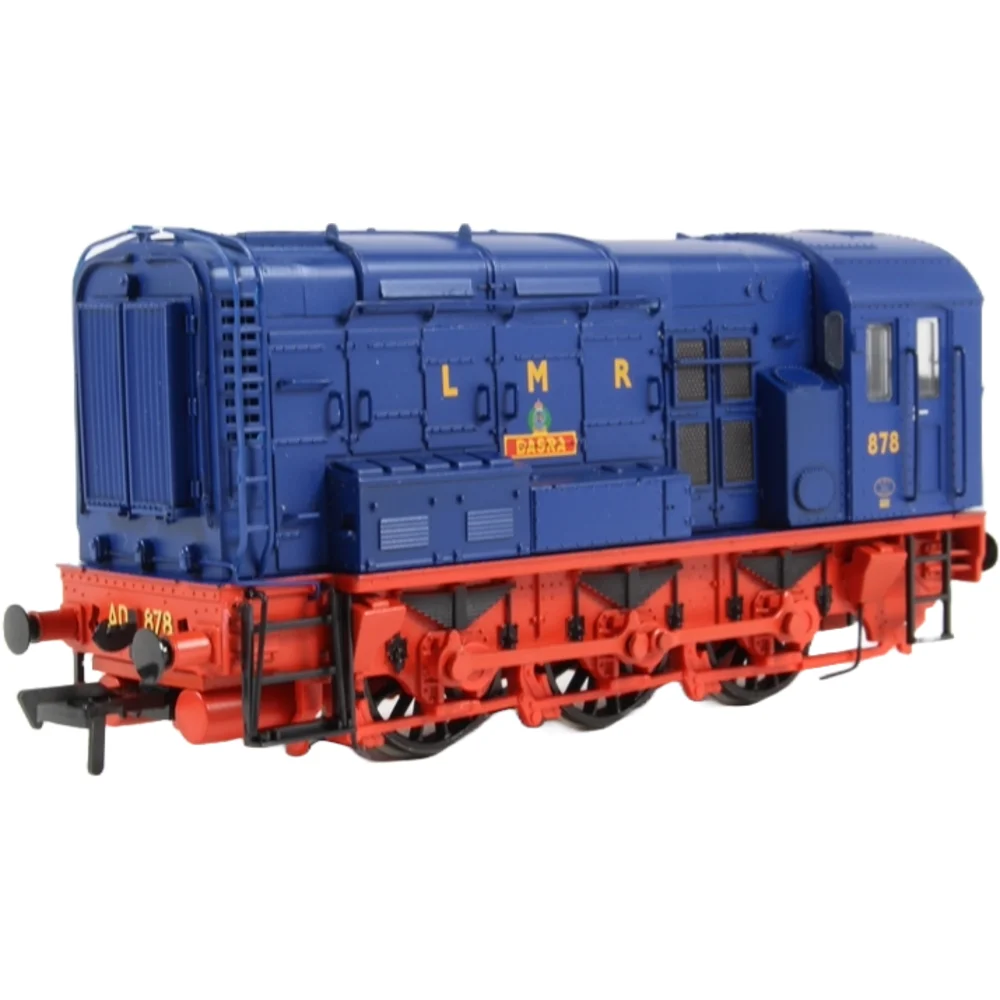Bachmann 32-102U
British Rail Class 08 878 "Basra" Longmoor Military Railway Blue
Tooling
In 2005, Bachmann introduced a revision to it's British Rail Class 08 tooling. This upgrade replaced the earlier 2000 design and reflected growing expectations for accuracy, mechanical refinement, and digital readiness in the UK model railway market. The revised tooling was developed to deliver improved fidelity and operational performance while maintaining compatibility with modern control systems.
Tooling Features
- Scale & Construction: OO scale (1:76.2), injection-moulded body shell with sharper moulding detail, die-cast chassis for strength and weight.
- Detailing: Enhanced prototype-specific options including lamp brackets, buffer types, radiator ladders, cab door variations, roof vent styles, and compressor boxes. Metal handrails and fine detailing parts were standard.
- Couplings: NEM pockets with tension-lock couplers fitted as standard, allowing easy conversion to alternatives.
Mechanical & Electrical Design
- Motor & Drive: Five-pole motor with flywheel for smooth, slow-speed control. Drive to all axles via precision gearing.
- Chassis: Sprung centre axle for improved track holding; all-wheel electrical pickup for reliable performance.
- Minimum Radius: Compatible with first radius curves.
- Weighting: Die-cast chassis provided excellent traction for shunting duties.
- Lighting: Provision for directional lighting was included in the design, though not all early releases featured factory-fitted lights.
DCC Capability
- The 2005 tooling incorporated an 8-pin decoder socket for straightforward DCC conversion.
- Sound-fitted versions were introduced later using the same chassis design, but the core revision was focused on DCC readiness rather than factory sound.
Liveries Produced (2005–Pre-Next Revision)
The revised tooling appeared in a wide range of authentic liveries, including:
- BR Green (early and late crest)
- BR Blue with yellow ends
- Railfreight sector schemes
- Regional and departmental variations
- Preservation-era colour schemes
Reception and Reviews
The 2005 revision was well received by the modelling press and enthusiasts. Reviews praised the improved body detail, robust chassis, and smooth running qualities. While not as advanced as later retoolings, it was considered a significant step forward from the 2000 tooling, particularly for its mechanical refinement and DCC-friendly design.
Media & Online Commentary
- Forum discussions highlighted the model’s reliability and ease of digital conversion.
- YouTube reviews from the period often compared the 2005 tooling favourably against older versions, noting its improved finish and running performance.
Interesting Insights
- The revision allowed Bachmann to standardise detailing options across multiple Class 08 variants without requiring separate body moulds.
- Its design anticipated the growing popularity of DCC, making conversion straightforward for hobbyists.
Conclusion
Bachmann’s 2005 revision of the Class 08 tooling delivered meaningful improvements in accuracy, mechanical quality, and digital readiness. While later retoolings would push standards even higher, this update established a strong foundation for modern shunter models and remains respected among collectors and operators.
Class & Prototype
- Class: British Rail Class 08
- Traction: Diesel
- Transmission: Electric
- Built: 1952-1962
- Total Built: 996
The British Rail Class 08 diesel-electric shunter represents Britain's most numerous locomotive class with 996 built 1952-1962. Powered by the reliable English Electric 6KT diesel engine producing 350-400hp, these 0-6-0 yard locomotives continue working after seven decades, with 100-170 still in active service alongside 87 preserved examples. The Class 08's universal deployment across freight yards, passenger stations, and industrial sidings from 1953 to present makes it the most versatile British diesel for model railway layouts.
No prototype found.
Operator & Livery
- Operator: Longmoor Military Railway
- Livery: Blue
The Longmoor Military Railway (LMR) was Britain's military railway training facility, operating from 1903-1969 in Hampshire. Built by the Royal Engineers, it trained soldiers in railway construction and operations for global deployment. The railway featured over 1,000 locomotives during its existence, including famous War Department Austerity designs in distinctive royal blue livery with red lining. Originally known as the Woolmer Instructional Military Railway, it was renamed LMR in 1935. The 8-mile system connected Bordon to Liss with a circular training loop, serving as a filming location for movies like Chitty Chitty Bang Bang and Bhowani Junction. Many locomotives survive in preservation, making LMR a popular subject for railway modellers across all scales.
The distinctive LMR blue livery was the standard paint scheme used on Longmoor Military Railway locomotives from the post-World War II period until closure in 1969. The scheme consisted of royal blue as the base colour, enhanced with red lining applied to frame components, coupling rods, and wheel tyres. Yellow lettering was prominently displayed on cab sides and tank sides, featuring "LMR" initials alongside locomotive numbers in standardised military fonts.
Contemporary accounts describe the livery as "royal blue lined red, with red rods and yellow lettering," creating a smart military appearance that distinguished LMR locomotives from civilian railway stock. Some sources also refer to it as "Oxford Blue" when describing rolling stock applications. The scheme maintained military standards of appearance whilst providing high visibility for safety purposes during training operations.
Variations existed within the standard scheme—some locomotives featured red frames and under foot plating with blue wheels, whilst others retained black frames with blue bodywork. Special occasions, such as locomotive naming ceremonies, included additional white wheel treatments. The livery was also applied to coaching stock and rolling stock, creating a cohesive visual identity across the entire railway.
For modellers, Precision Paints P16 (Royal Blue) provides accurate colour matching, with careful application of red lining and yellow lettering essential for authentic representation. The distinctive scheme remains popular among military railway enthusiasts and is featured on various ready-to-run and kit models across multiple scales.
